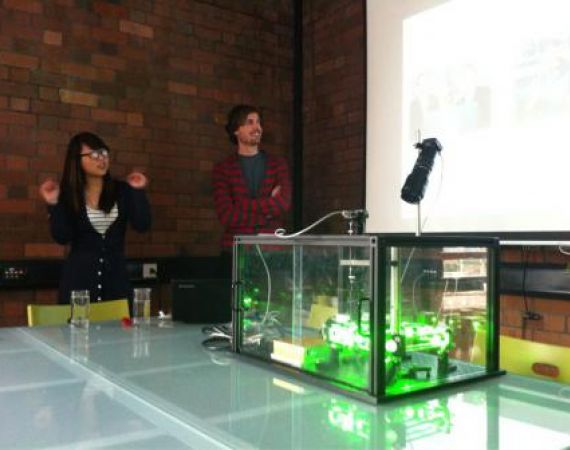Posted on Thu 22 Mar 2012
Lunchtime Talk: The Quantum Workshop: why isn't the world more weird?
Lia and James from The Quantum Workshop: part of the department of physics at UCL brought their public outreach project to the Pervasive Media Studio. They want to bring their specialism: experimental quantum physics to a wider audience.The Quantum Workshops mission statement is: Why isn’t the…

Lia and James from The Quantum Workshop: part of the department of physics at UCL brought their public outreach project to the Pervasive Media Studio. They want to bring their specialism: experimental quantum physics to a wider audience.
The Quantum Workshops mission statement is: Why isn’t the world more weird? Quantum mechanics predicts some strange behaviour which is experimentally proved in labs round the world all the time, what The Quantum Workshop question is: if weird stuff happens in labs, why doesn’t it happen in the real world?
To demonstrate the type of experiments that take place, Lia and James talked us through a classic quantum mechanics experiment called: ‘Young’s double slits experiment’, this is a study of what happens when something (anything) is fired at a surface with two small slits. Scientist’s tested this with tiny molecules called buckminsterfullerene (Bucky Balls), they were aimed at the slits, instead of being left with two separate piles opposite the slits, most of the molecules had gathered in-between the slits where there is no gap to fall through! The only way to explain this is by suggesting that the particle goes through both of the holes at once, therefore it can be in two places at the same time, which begs a question: Can people be in two places at once?
Quantum mechanic says that everything is in a superposition of places, which means everything has a slight spread of where it can be at the same time. The size and temperature of the object has an effect on the spread, for example the bigger and hottest of objects have the smallest spread and therefore the smallest chance of being in different places at the same time.
A way round this is to decrease the temperature of things and a good tool for doing this is a laser. Lasers contain a set single energy, which is displayed in its beam (a single colour); this beam can travel a long way staying completely intact unlike other light beams. This means lasers can be focused down to a very small size to be used very effectively in a small space.
The quantum workshop brought in their laser, they had split the beam into two channels and faced the separate channels into two lenses to produce an electric field that is squeezed into a tiny area, this force is strong enough to pull small objects and suspend them in between the two lenses. What this actually did was hold up a physical object and levitate it with light.
Questions from audience
What’s the largest object that has ever been frozen in one place like this?
Bucky Balls are the largest objects to undergo Young’s double slit experiment and prove that they can be in a superposition. It does depend on what you mean by large because the largest quantum gases are a millimetre in size and unbelievable sparse, they are like a wispy cloud.
Does it depend on what the object is made of?
This is about technique, when you have single types of atom it is quite easy because they collectively will follow the same rules of cooling and more complex atoms mean you have to think around what you can utilise in that object; using the shape of objects for example, rather than the physical make up of the object can do this.